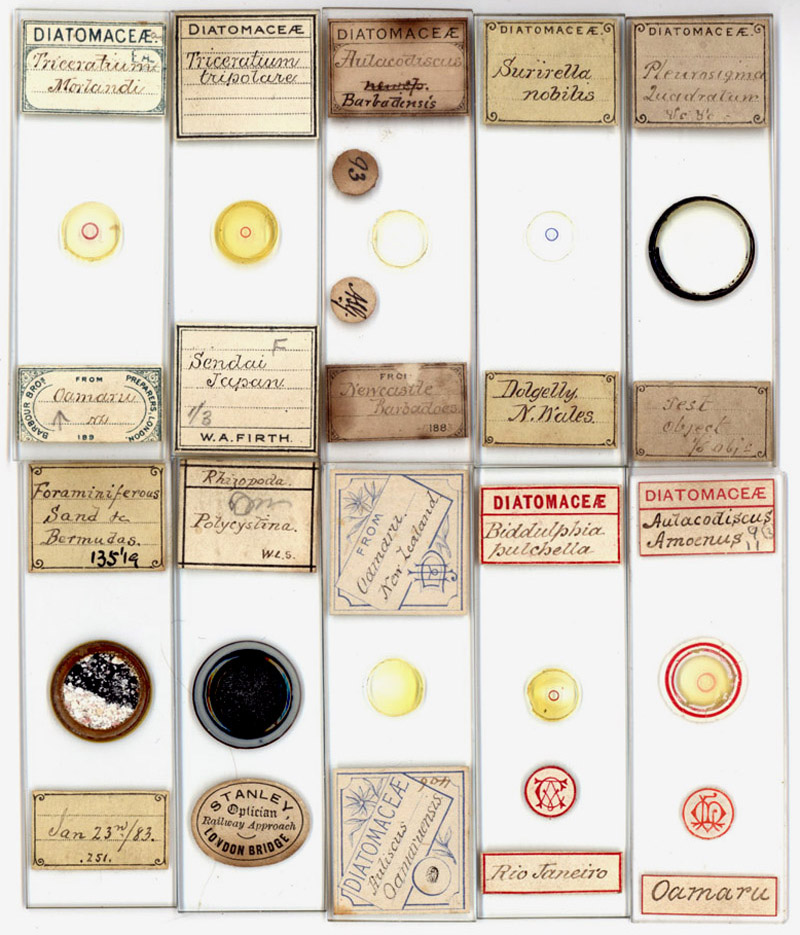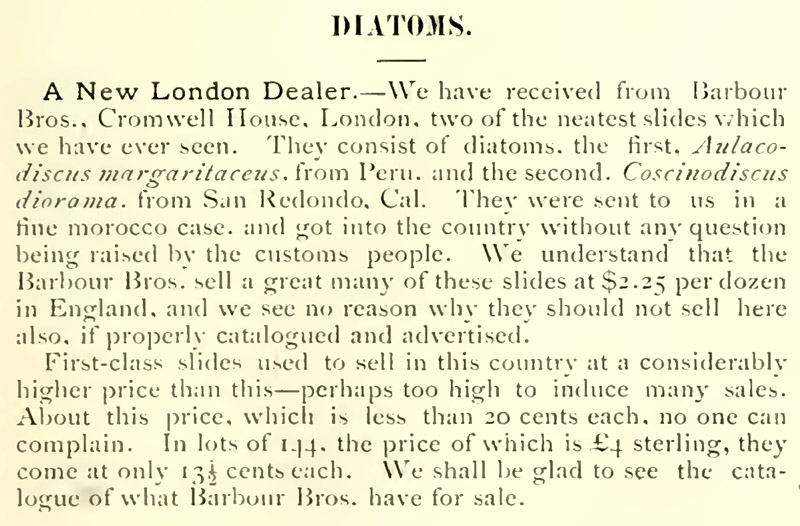James Morrison Barbour, 1851 – 1929,
and the Barbour Brothers Slide Business
by Brian Stevenson
last updated May, 2010
High quality diatom slides bearing the name “Barbour Bros.” are occasionally found
in collections and at auction. The
four slides shown in Figure 1 each hold one to four precisely-placed, perfect
diatoms. Pre-printed labels place their production during the 1890s. Brian Bracegirdle, in Microscopical Mounts and Mounters,
pointed out that the handwriting on Barbour Brothers’ slides resembles that of
W.A. Firth. While there are
similarities between those handwriting styles, there are also substantial
differences (Figure 2). Moreover,
the style of writing used by Barbour and Firth was fairly common, and can be
seen on slides by several other makers (Figure 2). The solution to the question of who made the Barbour
Brothers’ slides was recently unearthed with the discovery of an 1893 magazine notice, which
pointed to James M. Barbour as the maker of these slides. The identity of his brother(s) remains
a mystery.

Figure 1. Four
slides by the Barbour Brothers. The specimens are 1 to 4 precisely-located diatoms of the indicated
species. The lower labels were
pre-printed “189”, indicating production during the 1890s. The three different colors of printers’
ink suggest several orders for labels and an extended production run for the
Barbours’ slides.

Figure 2. A
Barbour Brothers’ slide and representative slides from W.A. Firth and several other known and unknown slide makers, for handwriting comparisons. The handwriting styles of William L. Sarjeant (WLS), John Day, Arthur
Cottam and Laurence Miles (lower row, rightmost four slides) share many features with Barbour and
Firth. Thanks to Peter Paisley for pointing out that numerous microscope slide
makers used similar handwriting styles.
Other than
their slides, the only record I found of the Barbour Brothers’ microscopy
business was a February, 1893 notice in the American
Monthly Microscopical Journal (Figure 3). The address given for the slide makers was Cromwell House,
London. Censuses were taken in
England every 10 years, beginning in 1841. The 1891 census recorded James M. Barbour as having lived at
6 Cromwell Terrace, otherwise known as “Cromwell House”, Kensington,
London. James Barbour had a known,
strong connection with microscopy: he became a member of the Quekett
Microscopical Club on January 19, 1894.

Figure 3.
Notice
about the Barbour Brothers’ microscopy business, from the February, 1893 issue
of the American Monthly Microscopical Journal. I have not located any further information on the Barbour
Brothers’ business, and do not know whether a catalogue was issued. By the following year, James Barbour
had moved to another location in London.
James Morrison Barbour was born 13 July, 1851, in Glasgow, Scotland. His father, Thomas, was master of a steam boat. Both of James’ parents died young. His father died 4 January, 1870 from a crushed arm and fractured ribs, having suffered for three days. Thomas’ death record noted that he was a widower, indicating that James’ mother, Ann, had died before that date. I have not been successful in locating information on her death. Intriguingly, there are no records of Thomas and Ann having any children other than James. As a caveat, there were no other children reported on the 1861 census, and by the next census, in 1871, both parents were dead. So it is possible that another son was born to Thomas and Ann, after 1861.
James Barbour attended medical school at the
University of Glasgow. In 1874, he
was appointed Fever Assistant to the Glasgow Royal Infirmary. He graduated in 1875 as a Bachelor of
Medicine (M.B.) and a Master of Surgery (C.M.). He practiced medicine in Glasgow for the next 2-3 years,
living at 146 Buccleuch St.
By early
1880, Barbour was in Bombay, India. He was elected to the Bombay
Branch of the Royal Asiatic Society on 14 January of that year. He also donated several books to the
Society during 1880. During 1888, Barbour held the post of Medical
Inspector of Seamen. Barbour
probably held that or a similar position throughout his time in Bombay.
He appears
to have returned to Great Britain by the end of 1888, as a letter from him to
the British Medical Journal was
published on 22 December, 1888, and postmarked London. On 4 December, 1890, Barbour married
Emily Smith in Kensington, London. Their marriage was reported in The
Lancet.
The 1891
census located James and Emily at 6 Cromwell Terrace, also known as Cromwell
House, in Kensington. That couple,
plus a live-in domestic servant, were the only occupants of the house. The 1893 notice regarding the Barbour
Brothers’ slide making business placed it at that location. It is possible that a brother(s) lived
with them by 1893. Alternatively, James’ business partner(s) may have lived
elsewhere in London and commuted to help make slides, or may even have lived
elsewhere and functioned as supplier of mounted or unmounted diatoms.
As noted above, Barbour was elected to the Quekett
Microscopical Club in 1894. He was
also elected to the Royal Geographical Society, in 1883, apparently as a
corresponding member, since other evidence indicates that he lived in India at
that time.
By January, 1894, the Barbour family had moved to 18 Nevern
Road, Earl’s Court, London. The
1897 Royal Blue Book listed Barbour
as being “at home” on the first and third Thursdays of each month.
The 1901 census found James and Emily living at Swiss
Cottage in Swannage, Dorset. They
appear not to have had any children. At census time, they were hosting Emily’s sister, Fanny, who was a sick nurse. The household also included a widowed
boarder and a young servant girl. James worked at the Mendip Hills Sanatorium. At around this time, he wrote an English adaptation of
treatments for tuberculosis.
The Barbours moved to Ramsey, Isle of Man, in 1903 or
1904. James served as the area’s
Medical Officer of Health for many years. During his years of medical practice, Barbour contributed to numerous
medical journals and books. James
Barbour passed away in February, 1929, and his wife, Emily, died in November,
1937.
Acknowledgements
Thanks to Peter Paisley and Howard Lynk for sharing their
thoughts on the Barbours and for ongoing discussions on historical microscopy.
Resources
The American Monthly
Microscopical Journal (1893) Vol. 14, February, page 57.
Barbour, J.M. (1879) Two cases illustrative of chyluria, Glasgow Medical Journal, Vol. 11, pages 24-27.
Barbour,
J.M. (1902) Medical and surgical appliances, perineum guard, British Medical Journal, May 5, page 1092.
Barbour,
J.M. (1909) Letter, British Medical
Journal, Vo1. 2, page 296.
Bracegirdle,
Brian (1998) Microscopical Mounts and
Mounters, Quekett Microscopical Club, London.
British Medical Journal (1888) December
22, page 1424.
British Medical Journal (1902) A
pocket sputum flask, February 22, page 465.
The India List Civil and Military (1888) W.H. Allen, London, page 170.
Isle of Man Examiner Annual
(1908)
Town and Village Commissioners of Ramsey.
Isle of Man Examiner Annual (1918) Medical
practitioners in Isle of Man, and Town and Village Commissioners of Ramsey.
Journal of the Bombay Branch of the Royal Asiatic Society
(1880), Vol. 14, pages lv, lix-lx lxiv and lxviii.
Journal of the Quekett
Microscopical Club (1894) Second Series, Vol. 5, page 382.
Journal of the Quekett
Microscopical Club (1895) Second Series, Vol. 6, page iii (list of
members).
Knopf, S.A. (1899) Tuberculosis
as a Disease of the Masses, and How to Combat it, adapted for use in
England by J.M. Barbour, Rebman, London.
Lancet (1890)
Vol. 2, page 1309.
Maclean, James Mackenzie (1889) A Guide to Bombay, Historical, Statistical
and Descriptive, page 19.
The Manx Lawsons & Related Families, Burials, Babb to
Bardwell, http://www.lawsons.ca/burials/ba_01.html
Manx Year Book (1914)
Manx motor cars, owners, numbers and H.P.
Medical Bibliography for
1877, page 852 (address of J.M. Barbour).
Medical Help on Birth
Control (1928) Putnam, London.
The Medical Press (1874),
Appointments, New Series, Vol. 18, November 25, page 473.
Proceedings of the Royal
Geographical Society (1883) Vol. 5, page 296.
Register
of Members of the General Council of the University of Glasgow (1926)
Royal Blue Book: Fashionable Directory and Parliamentary Guide (1897) page 568.
Service, John (1876) Cases of abortion in enteric fever, Glasgow Medical Journal, Vol. 8, pages
495-497.
University of Glasgow alumni records for James Morrison
Barbour, http://www.universitystory.gla.ac.uk/biography/?id=WH8130&type=P
Vital statistics of England, Scotland and the Isle of Man,
accessed through www.ancestry.co.uk.


